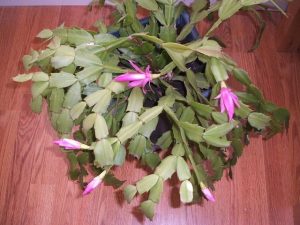Schlumbergera bridgesii is the proper name for the well-known forest cactus, or Christmas cactus. As its common name implies the Christmas cactus flowers in mid-winter. Though some do flower for Christmas, the natural flowering season for others comes later. This member of the cactus family is native to the tropical jungles of Brazil and is epiphytic, attaching itself to trees that grow on mountains up to 4,800 feet. They prefer darker, wetter conditions than the desert cacti, and need peat-based, soilless mixes, and year-round watering. Generally, these plants are treated like ordinary house plants.
There is a lot of confusion surrounding the holiday cacti: Christmas cactus, Thanksgiving cactus, and Easter cactus. The easiest way to tell the difference is by looking closely at the leaves. Christmas cactus leaves are smooth with scalloped edges. The Thanksgiving cactus has more-pointed teeth along the edges of the leaves. The Easter cactus has a thicker, slightly more upright leaf and often has a purple or maroon color along the leaf edge. Easter cactus also has brittle-like hairs, often called cat whiskers, at the stem joints. These sound like hard and fast rules, but unfortunately, there are a lot of crosses that can make it hard to distinguish between many of the new hybrids. Fortunately, each cactus plant produces beautiful, colorful blooms, and can last 50 years or more.
The Christmas cactus likes bright conditions but not direct sun. It needs watering about once every three weeks in midwinter and an increase in the frequency of water as summer approaches. If it is budding or in bloom, give the cactus a little extra water.
To bloom, many of the forest cacti need cool nights as close to 50 degrees as possible. A few forest cacti blooms are also triggered by the length of the night, as long as they are in a place that gets uninterrupted periods of darkness. If lights are turned on regularly, it might cause some confusion, but if you have continuous cool nights, then the length of the night is a secondary concern. After the blooms die, treat these plants more like a desert cactus, with more infrequent watering until summer.
Caring For Your Forest Cactus: We have already talked about light, temperature, soil, and watering, Let us now touch on feeding, repotting, cleaning, and pest control.
Feeding: Use high-potash fertilizer once a month in the spring, summer, and autumn. Do not feed while flowering.
Repotting: Repot each year into the next-size pot, handling the root-ball carefully because they dislike having their roots disturbed. The base of the plant becomes woody with age, and it is a good idea to propagate new plants. Approximately one month after flowering, take cuttings of two segments, cutting at the joint with a sharp knife. Dust both cut ends with hormone rooting powder containing fungicide and let dry for two days. Place end of cutting gently into an almost dry soilless mix, planting about 1/2 inch deep. Then water after two weeks.
Cleaning and pests: Spray at least once a week to keep your plants fresh and dust-free. For any pests or disease problems, please refer to the UC IPM website for answers. Here is the link for cactus:
http://ipm.ucanr.edu/PMG/GARDEN/PLANTS/cactus.html
Betty Hensley is a University of California Cooperative Extension Master Gardener of Tuolumne County.
UCCE Master Gardeners of Tuolumne and Calaveras Counties can answer home gardening questions. Call 209-533-5912 or fill out our easy-to-use problem questionnaire here. Check out our website here. You can also find us on Facebook.

